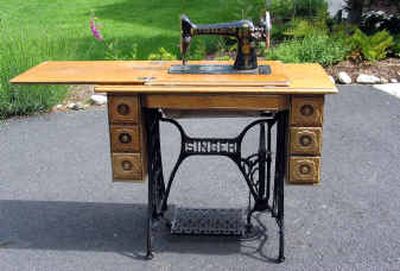Nostalgia spurs purchase of antique sewing machine

I haven’t been looking for a sewing machine because I can’t sew. Well, to be technical about it, I can sew but I’m not very good at it and I don’t enjoy it.
When my daughters wanted to learn to sew, I found someone else to teach them because all they would have gotten from me was a quick tutorial on how to swear. And really, as a parent that’s the kind of thing I’d rather they picked up on their own.
So when I stopped by a moving sale down by the Spokane River, my eye skipped right over to the old treadle machine standing in the driveway. I was about to leave the sale with empty hands when I spotted it.
The golden oak case was in pretty good condition. There were a couple of white rings on the top and a few minor scratches, but on the whole it was in really good shape.
All of the drawers — three on each side — were there, as was most of the decorative trim. The only missing piece was a tiny bit of molding on the front drop-down drawer. The patent date — July 20, 1903 — was written on the metal plate that covered the bobbin.
As I looked over the machine, I was reminded of my great-grandmother’s old Singer treadle sewing machine and of her.
She was born in the rural South in the late 1880s. She married a coal miner, gave birth to seven children and was in her 30s when he died of lung disease. She never remarried and raised the children by working their small farm alone. She survived the Great Depression, lost most of her possessions in two separate house fires, and, saddest of all, outlived all of her children before she died at 102.
She was a tiny woman, but she was incredibly tough. I can imagine her working the treadle of her old Singer, pushing sturdy fabric under the needle to sew clothing and other necessities for her household. They didn’t have a lot and most of what they did have was handmade. The machine was passed down to my grandmother and then to my mother. It was sold in her estate after her death.
I didn’t sew and didn’t have room for it so I let it go. But later I regretted not keeping it. When my girls got interested in sewing, I thought about how much fun, and less threatening, it would be to learn on that old treadle machine instead of a complicated modern one.
People who love old things often find themselves picking up an item that is familiar, reminding them of something they, or someone close to them, once owned. I saw it all the time when I had my antiques business. People bought lunchboxes similar to the one they carried to school, or dishes like their mother’s. Nostalgia accounted for more sales than marketing ever did.
Sometimes it isn’t the object as much as what the object stands for that grabs us, and that’s exactly what happened to me when I loaded that old treadle sewing machine into the back of my car.
Sure, it’s a nice piece of golden oak furniture, an interesting antique, and the price was certainly right. But what made the sale of that basic sewing tool was the memory of a little woman who lived a long life full of hard work.
A little history
Although Elias Howe got the first American patent on a sewing machine, Isaac Singer was credited with bringing the invention into the public eye. His marketing slogan — “A sewing machine in every home” — and the advent of installment payments made Singer Sewing Machines a household product.
The first commercial sewing machines came out in the late 1850s and by 1905 the first electric machines were in use. They helped usher in the age of “ready made” clothing.
Antique and vintage sewing machines have many admirers. They are prized for their handsome furniture-like cases and for the simply beauty of the machines themselves.
Coming up
The public is invited to the first MarketDay at MaryJane’s Farm on July 3 and July 4 from 11 a.m. to 4 p.m. Admission is free.
MaryJane’s Farm is located eight miles southeast of Moscow, Idaho, and is the home and business headquarters for MaryJane Butters’ mail-order organic prepared foods.
Her foods and her storefront magazine, titled MaryJane’s Farm, are distributed across North America, and she recently signed a $1.35 million book contract with Random House
Tours of the farm, antiques, collectibles, u-pick flowers and vegetables, musical entertainment and lunch will also be available.
For more information, call (208) 882-6819 or check the Web at www.maryjanesfarm.org.